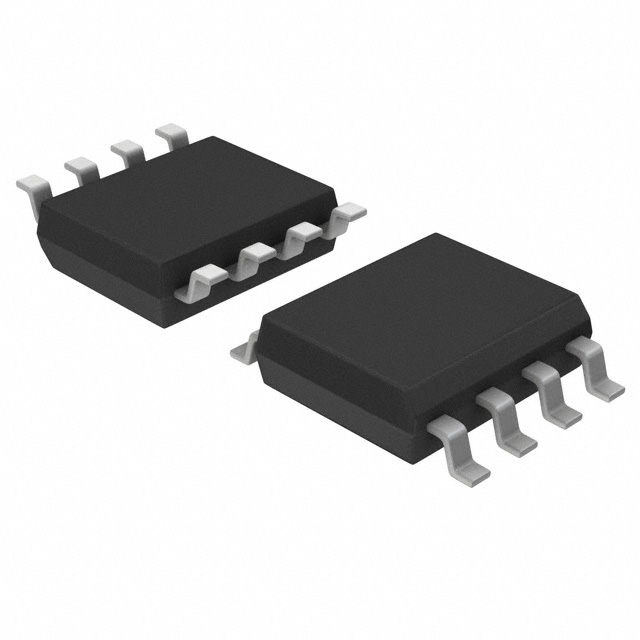TLC252CDRG4
Product Overview
- Category: Integrated Circuit (IC)
- Use: Operational Amplifier
- Characteristics: Low-power, Rail-to-Rail Input/Output, Dual Operational Amplifier
- Package: SOIC (Small Outline Integrated Circuit)
- Essence: The TLC252CDRG4 is a dual operational amplifier designed for low-power applications. It offers rail-to-rail input and output capabilities, making it suitable for a wide range of voltage levels. The IC comes in a small outline integrated circuit package, which provides ease of use and compatibility with various circuit designs.
- Packaging/Quantity: The TLC252CDRG4 is available in tape and reel packaging, with 2500 units per reel.
Specifications
- Supply Voltage Range: 2.7V to 16V
- Input Offset Voltage: 1mV (maximum)
- Input Bias Current: 1pA (typical)
- Gain Bandwidth Product: 2.2MHz (typical)
- Slew Rate: 1.3V/µs (typical)
- Operating Temperature Range: -40°C to +125°C
Pin Configuration
The TLC252CDRG4 has a total of 8 pins, which are assigned as follows:
- OUT1: Output 1
- IN-1: Inverting Input 1
- IN+1: Non-Inverting Input 1
- V-: Negative Power Supply
- IN+2: Non-Inverting Input 2
- IN-2: Inverting Input 2
- OUT2: Output 2
- V+: Positive Power Supply
Functional Features
- Low-power consumption
- Rail-to-rail input and output operation
- Wide supply voltage range
- High gain bandwidth product
- Low input offset voltage and bias current
Advantages and Disadvantages
Advantages
- Low-power consumption makes it suitable for battery-powered applications.
- Rail-to-rail input and output operation allows for maximum utilization of the available voltage range.
- Wide supply voltage range provides flexibility in various circuit designs.
- High gain bandwidth product enables accurate amplification of signals.
- Low input offset voltage and bias current ensure precise signal processing.
Disadvantages
- Limited output current capability compared to some other operational amplifiers.
- Slightly higher input noise compared to certain specialized amplifiers.
Working Principles
The TLC252CDRG4 operates as a dual operational amplifier, utilizing a differential input stage followed by a gain stage. It is designed to amplify small input signals with high accuracy and low distortion. The rail-to-rail input and output capability allows the IC to handle signals that span the entire supply voltage range. The low-power consumption ensures efficient operation in battery-powered devices.
Detailed Application Field Plans
The TLC252CDRG4 can be used in various applications, including:
- Portable audio devices: The low-power consumption and rail-to-rail operation make it suitable for amplifying audio signals in portable music players, smartphones, and headphones.
- Sensor interfaces: The wide supply voltage range and low input offset voltage/bias current make it ideal for amplifying signals from sensors such as temperature, pressure, and light sensors.
- Battery-powered systems: The low-power consumption and rail-to-rail operation make it suitable for use in battery-powered systems, such as wireless sensor networks and remote monitoring devices.
- Industrial control systems: The high gain bandwidth product and low input offset voltage/bias current make it suitable for precise signal conditioning and amplification in industrial control systems.
Detailed and Complete Alternative Models
Some alternative models to the TLC252CDRG4 include:
- LM358: Dual operational amplifier with low-power consumption and rail-to-rail input/output.
- MCP602: Dual operational amplifier with low-power consumption, rail-to-rail input/output, and extended temperature range.
- AD8628: Dual operational amplifier with low noise, low-power consumption, and rail-to-rail input/output.
These alternative models offer similar features and can be considered as substitutes depending on specific application requirements.
Word count: 488 words
10个与TLC252CDRG4在技术解决方案中的应用相关的常见问题及解答
Question: What is TLC252CDRG4?
Answer: TLC252CDRG4 is a dual operational amplifier that is commonly used in various technical solutions.Question: What is the supply voltage range for TLC252CDRG4?
Answer: The supply voltage range for TLC252CDRG4 is typically between 3V and 16V.Question: What is the input offset voltage of TLC252CDRG4?
Answer: The input offset voltage of TLC252CDRG4 is typically around 1mV.Question: What is the common-mode rejection ratio (CMRR) of TLC252CDRG4?
Answer: The CMRR of TLC252CDRG4 is typically around 90dB.Question: What is the bandwidth of TLC252CDRG4?
Answer: The bandwidth of TLC252CDRG4 is typically around 1MHz.Question: Can TLC252CDRG4 be used in single-supply applications?
Answer: Yes, TLC252CDRG4 can be used in both single-supply and dual-supply applications.Question: What is the input bias current of TLC252CDRG4?
Answer: The input bias current of TLC252CDRG4 is typically around 20nA.Question: Does TLC252CDRG4 have built-in protection features?
Answer: Yes, TLC252CDRG4 has built-in short-circuit and thermal protection features.Question: What is the package type of TLC252CDRG4?
Answer: TLC252CDRG4 is available in an 8-pin SOIC package.Question: What are some typical applications of TLC252CDRG4?
Answer: Some typical applications of TLC252CDRG4 include active filters, instrumentation amplifiers, and signal conditioning circuits.


